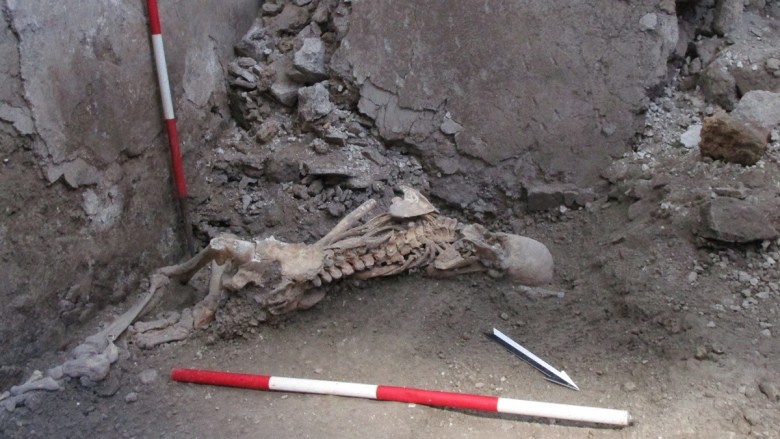
Mount Vesuvius still looms over the ancient Roman city of Pompeii in southern Italy’s Campania region, where thousands perished during two violent days in 79 CE.
Researchers have long accepted that residents died when pumice and ultrahot flows of gas and debris overtook the city. A new study published in Frontiers in Earth Science suggests that strong earthquakes added an additional dimension to the event.
“Our study reports the first clear evidence of earthquake-induced damage during the eruption,” said volcanologist Domenico Sparice of the National Institute of Geophysics and Volcanology in Naples, Italy.
Excavations at the Insula of the Chaste Lovers in Pompeii uncovered the battered skeletal remains of two men beneath toppled walls. The new research indicates the men perished before the deadliest phase of the eruption and suggests that earthquakes played a pivotal role in the disaster.
Compound Disaster
Building on the firsthand accounts of Pliny the Younger and other studies, the multidisciplinary team pieced together a precise timeline of events.
“The real strength of the research derives from the strict collaboration of archaeologists and volcanologists.”
“The real strength of the research derives from the strict collaboration of archaeologists and volcanologists,” said Raffaello Cioni, a volcanologist from the University of Florence in Italy who was not involved with the study.
During excavations at the Insula of the Chaste Lovers, archaeologists uncovered two skeletons and multiple toppled walls buried between distinct layers of volcanic rocks, products of discrete phases of the eruption.
The first, Plinian phase began around 1:00 p.m. as an enormous eruption column from Mount Vesuvius rained down pumice on surrounding towns. The positioning of the skeletons above a thick layer of pumice suggests that these individuals survived this first day’s chaos by seeking shelter indoors.
During the second phase, the collapse of the eruption column buried Pompeii under scalding, fast-moving currents called pyroclastic flows. Unlike victims who perished in the flows due to asphyxiation, dehydration, or heat, however, the men in the Insula of the Chaste Lovers appear to have sustained crush-like injuries to their ribs, pelvises, and skulls. The researchers found one man crouched, shielding his head, apparently aware of imminent danger.
The new research is primarily concerned with the morning hours between the major phases, when Pompeii and surrounding towns were hit by strong earthquakes “chronologically consistent with the beginning of the caldera-forming phase of the eruption which was accompanied by strong seismic shocks,” the authors write. Although earthquakes were common in Campania, these quakes were strong enough to be referenced by Pliny in his letters to Tacitus.
“This research highlights the ongoing risks faced by communities living near Vesuvius today.”
In the Insula of the Chaste Lovers, the orientation of the room’s fallen walls allowed researchers to trace the precise path of destruction and determine that it happened during that quake-riddled morning. “The collapse of the building occurred before the arrival of the pyroclastic currents,” Sparice said.
The effects of these earthquakes may have been neglected when assessing the broad history of the eruption, researchers argue. Sparice and his coauthors question whether some instances of Pompeian destruction have been attributed to volcanic activity but are actually seismic in nature. Furthermore, quakes may have heightened fear and panic, driving citizens into the streets, where they were exposed to pyroclastic flows. “Unfortunately, this was not a life-saving choice,” Sparice said.
Claudio Scarpati, a volcanologist from the University of Naples, said this isn’t just ancient history. Mount Vesuvius is still an active volcano and just 9 kilometers away from his home in Naples, home to more than 3 million people. “Studies like [this] are invaluable in creating a more comprehensive understanding of the events that occurred 2,000 years ago,” he explained, adding, “this research highlights the ongoing risks faced by communities living near Vesuvius today.”
—Evan Howell, Science Writer
Citation: Howell, E. (2024), Earthquakes may have amplified the destruction of Pompeii, Eos, 105, https://doi.org/10.1029/2024EO240351. Published on 5 August 2024.
Text © 2024. The authors. CC BY-NC-ND 3.0Except where otherwise noted, images are subject to copyright. Any reuse without express permission from the copyright owner is prohibited.
Related
